NÜMOD
NÜMOD
THE YURT
A concise history
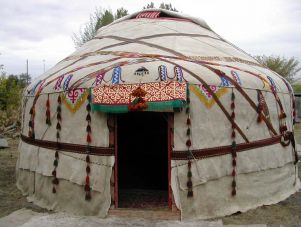
Shelter is one of the most fundamental and utilitarian arts employed by man. It fulfills our most basic need. It is the symbolic center of family life and cultural identity. It is a visual reflection of our modes of life. Let us briefly critique modern industrial shelter. The modern architect attempts to defy nature. Unsustainable resources are readily imported from around the world, while local resources are not even considered. Climate control eliminates attention to local climate. Structures drawn up by distant and detached architects, are standardized for budget efficiency, denying the psycho-spiritual needs of the future inhabitants. In comparison, the assumed simple structural designs of nomads are in fact a “complex calculus...evolved to meet a range of geographic conditions, climate variations and inherited traditions.” Nomadic architecture has achieved an equilibrium between “physical and cultural needs”. Frank Lloyd Wright wrote that "the true basis for any serious study of the art of architecture still lies in those indigenous, more humble buildings everywhere that are to architecture what folklore is to literature or folksong to music . . . these many folk structures are of the soil, natural. Though often slight, their virtue is intimately related to environment and the heart-life of the people." There are many types of nomadic and semi-nomadic structures in use, but arguably the most ingenious of these is, the yurt. In this paper, I will present a brief historical background on the yurt, a description of its physical construction, and thoughts on the relevance and use of the yurt in society today.
Figure 1: Anatomy of Yurt Construction.
The English word Yurt comes from the Russian Yurta describing a circular trellis walled framed tent. The Russian word Yurta is derived from a Turkic word describing a camping ground. The roof is supported by a conical or domed frame consisting of a number of ribs radiating from a central wooden wheel to the top of the wall trellis. Due in part to the scarcity of trees, nomads resorted to a material they had in abundance, felt made by beating and rolling wet sheep fleece. In fact the origin of the word «nomad» came from a word for felt, thus making the «nomads» the felt people.
The yurt living nomads, were groups existing in the inner Asian step. Theirs was a complex system of spatially delimited movement patterns, following the seasonal migrations of sheep, horse, goat, cow, camel, and donkey. Where most considered the inner Asian steppe wasteland, due to unfit conditions for agriculture. The nomads mastered the ecological problems of steppe life, living as nomadic pastoralists. In Symbiosis with their heard animals, they created a sustenance from the steppe by harnessing the abundant recourse of grass. Unlike the wanderer, the nomad moved with attention and purpose.To remain in equilibrium with the grass cycles, the nomads recognized the patterns of seasonal depletion and annual return. Thus, the nomad required a home, that was convenient to transport, and adaptable to diverse weather conditions.
The evolution of the modern ger almost certainly began in prehistoric times with the urts or buheg; a tipi like structure, still used by the reindeer breeders of Northern Mongolia and Siberia .
Evolution of the Ger
The Nomads of the inner Asian step, kept no written history, so early evidence of the history of the yurt is hard to find. Bronze age rock etchings from Siberia appear to show yurts in use. Descriptions from ancient travelers and some frozen remains offer hints, but no absolute proof. Herodotus (c480-c425 BC) described ger-carts and felt tents being used by the Scythian people. A cart found in a 2500 year old Pazaryck grave in Southern Siberia demonstrate all of the technologies needed to build a yurt were available at that time.4 The oldest complete yurt yet discovered was in a 13th century grave in the Khentei Mountains of Mongolia, Genghis Khan's. Since this time the design has changed little, the ger being perfectly suited to a nomadic lifestyle in a range of climates. The mongolian's are definitely the most famous for their yurt use, still housing nearly three quarters of the population, although there are many other countries where the yurt is still in use.*
Spread of the Yurt.
Today, there are two major types of yurts in use, the Mongolian ger, and the Turkish bentwood yurt. There are minor differences. Where the Mongolian yurt has a strait roof beams, the Turkish has bent ones that resemble the shape of the ancient inner Asian step nomads pointed hat. The beams of the bentwood yurt compromise part of the wall and morph into the roof. The Mongolian's consider a heavy door a sign of wealth, while the Turkish yurt has lighter doors or a felt flap. Often the flap is finely decorated with colorful patterns. The yurt can be insulated for winter use, the sides rolled up to admit a cooling breeze on hot days. «On clear nights one can lie in bed and watch the stars through the open crown. On wet nights there is plenty of room for a group of friends to sit in comfort around a warm stove, tell stories and listen to the storm outside. The atmosphere inside the yurt is one of warm, secure, solidity, while from the outside the yurt radiates a welcoming glow.»
In 1245-1247 Pope Innocent IV sent Friar Giovanni DiPlano Carpini, on a mission to offer Christianity to the Mongols whilst also finding out as much as possible about their origins and habits. At this time all of Europe was in fear of another Mongol invasion. Carpini travelled for two and a half years, reaching, though not actually visiting the ancient Mongol capital of Kharakorum, and being present at the enthronement of Guyuk Khan, he described the Mongol dwellings thus:
“Tartar homes are round and prepared like tents made cleverly of laths and sticks. In the middle of the roof there is a round window through which light comes in and smoke can leave, because they always have a fire in the center. The walls and the roof are covered by felt and even the doors are made of felt. Some huts are large and some are small, depending upon the wealth or poverty of the owners. Some are taken apart quickly and put back together again and carried everywhere; some cannot be taken apart and are moved on carts. The smallest are put a cart drawn by one ox, the larger by two or three or more depending upon how large it is and how many are needed to move it. Whenever they travel, whether to war or other places, they always take their homes with them.”
Genghis Khan's ger cart pulled by oxen (13 th century)
Having been home to the many tribes and cultures of central Asia for millennia a great deal of traditions, superstition, religious significance and custom has built up surrounding the yurt. To the nomads, in the construction the whole universe is represented: The roof represents the sky and the smoke hole the sun. The hearth contains the five basic earth elements of earth, wood, fire, metal, and water (metal in the grate and water in the kettle). The sacred circle represents the center point of the universe and the perfection within all of us. For many, the fire holds the deity of the house, and to it, sacrifices are made. Rubbish should not be burned in the fire and outsiders should not take a light from it. The shrine is set up opposite the door, people sleep with their heads towards this altar.10The yurt is set up with the door facing south. When families camp together during the winter the group of yurts or aul are set in a circle. The roof poles and crown are carried in through the door, it is considered bad luck to pass them over the wall. The interior furnishings and seating arrangements are always the same.
Traditional furnishing and seating in the ger.
Guests from afar are offered food and stay, although they must remain their respected palace in the yurt, a large feast is prepared. When entering the yurt it is considered impolite to step on the threshold or to hold onto the ropes. There are a set of standard traditional greetings, much like our modern greetings of, whats up, not much, how are you, good, how was your day...etc.* After exchanging greetings, the good drinks of the house are offered in specific orders. + Strong rules that must be followed by all guests include leaving weapons outside, avoiding steping on the entrance, and pointing your feet at or putting rubbish on the fire.
In recent times the yurt has been rediscovered in the west. The furthest west, the yurt had previously reached was hungary where the Magyar nomads predominantly discontinued its use as they became a westernized feudal society. The yurt became something of interest to many as in 1962 National Geographic article by Supreme Court Justice William O. Douglas about his trip to Mongolia. A few yurt workshops started compromising some of todays most prominent yurt companies. Among the notable yurt makers and users of the west were the Hoedad, a group of tree planting hippies working to restore the forests of Oregon. Many other yurt communities followed suite and sprung up around the nation. David Raitt, at the age of 17 years old began to build yurts and founded many such communities. Many in the west consider the yurt to be a gift of ancient knowledge, only recently available to modern culture. It is regard as an ideal home or shelter. Affordable, accessible, spiritual, simple, communal, harmonic, realistic, and adaptable are among the yurts positive attributes.
Hoedad tree planter yurt.
The yurt is a self-supporting structure; the frame holds its shape with no help from guy ropes or a stretched cover. In all but the strongest winds the yurt will stand with nothing but gravity attaching it to the ground. This rigidity is maintained by opposing forces exerted by different parts of the frame. The walls are firmly tied to the doorframe to form a complete circle. The conical or domed roof, with its heavy crown exerts a force on top of the walls. This force is kept in check and put to advantage by strong bands tied tightly around top of the wall. These opposing forces give the frame great rigidity, which is further reinforced with the addition of downward pressure from a heavy roof cover and the inward pressure from tight wall covers.
Opposing pressures which give the yurts its inherent rigidity
The yurt has an aerodynamic shape, the wind slips over the structure with minimal resistance. There are no flat or concave surfaces to catch the wind. The yurt will not blow down like an ordinary tent but can, in exceptional circumstances, be lifted by a strong gust of wind through the door. So always peg the yurt down.
Airflow over the Mongolian yurt
The shape of the yurt is very thermally efficient. A large yurt can be easily kept warm using a small wood burning stove down to -5°C without any additional insulation. In Central Asia layers of thick felt keep the yurt warm as the outside temperature drops well below -40°C. In hot weather the sides can be lifted: warm air rises and exits through the open tono drawing cool air in at the bottom.
Airflow inside the yurt during hot weather
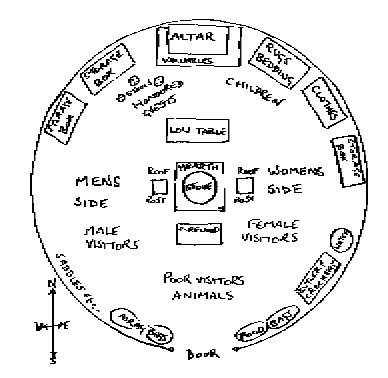
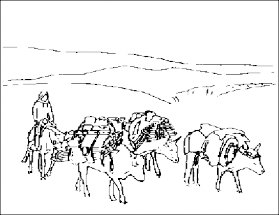
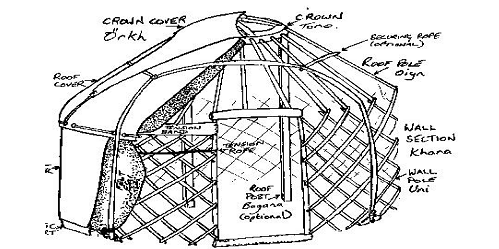
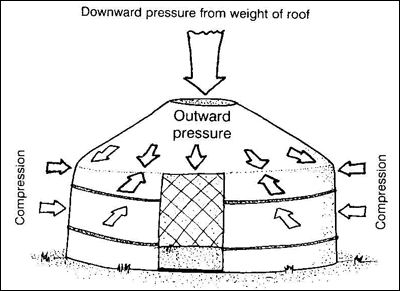
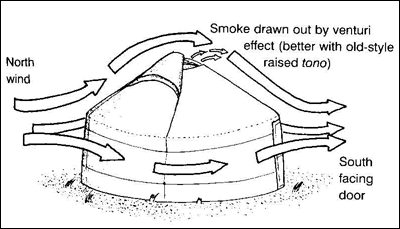
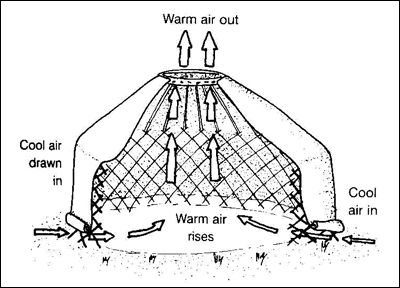

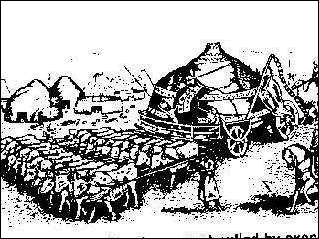
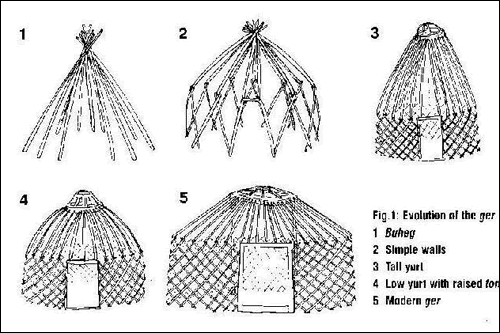

Home
About
Contact
Manifestos
Yurts
The Clan
Photos
The Heard
The Migration
Support
Friends
Press